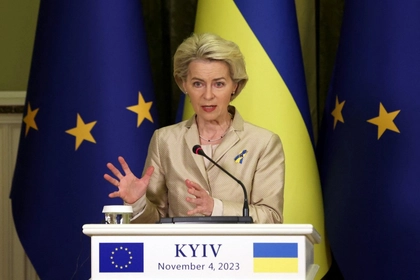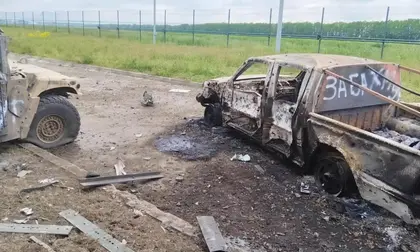Early on Monday morning, 22 May, a group of armed insurgents crossed the border from Ukraine, advanced several kilometers into the Russian border region of Belgorod and set up camp there. Who were they? Anti-Putin Russian para-military groups have claimed responsibility for the attacks, and Kyiv has denied any involvement. The Kremlin claims it repelled the advance, which was followed on Wednesday by drone attacks.
Rebellion a long-standing tradition in Russia
For Poland’s Rzeczpospolita, an armed revolt is a distinct possibility:
JOIN US ON TELEGRAM
Follow our coverage of the war on the @Kyivpost_official.
“The porous border, the fighting around the Belgorod region and the ongoing diversionary maneuvers in various regions show that an armed rebellion is once again a possibility in Russia more than a century after the 1917 Revolution and the civil war. The cult of armed resistance against the powerful has been cultivated in Russia for decades - and not just since the Soviet era. Lenin's mausoleum still stands in the heart of the Russian capital, though Lenin did not come to power through 'peaceful protests'.”
A problem for Washington
Russian channels have disseminated images of supposedly abandoned Western military vehicles in Belgorod - including US-made Humvees. Czechia’s Lidové noviny speculates:
“This could have been a coincidence. The Ukrainians armed the Russian volunteers with this technology simply because they had it and didn't give it too much thought. Or it was no coincidence and they wanted to show that they will not be restricted in their use of Western technology. Either way, it's a problem for Washington and has upset some politicians there. So the Americans have repeated that the Ukrainians have no permission to hand over this technology to paramilitary organizations or use it to attack Russian territory.”

EU Transfers €1.5 Bln Raised From Russian Assets for Ukraine
A tricky tit-for-tat
Ukraine is using a trick once used by Russia, writes exiled Russian oligarch Mikhail Khodorkovsky in a Telegram post republished by Echo:
“When Putin concocted the scheme with 'local militias' and 'civil war' in Donbass in 2014, little did he think that two could play this game. ... Now we see Russian helicopters shooting at Russian citizens on Russian territory. ... This sortie is another reminder that you can't invade another country, destroy several cities and then dictate how that country is allowed to defend itself against the invasion. Under international law, Ukraine can attack the territory of the aggressor state and transfer the hostilities to Russian territory.”
The Russian borders are unprotected
This attack will force Russia to withdraw troops from Ukraine, military expert Yevhen Dikiy writes on the website of Ukrainian Radio:
“For the first time during the war, a piece of recognized Russian territory is not under Moscow's control. And now Moscow will move troops there to drive out the Russian volunteers, or those who came with them. But where will they get these troops from? I doubt very much that there are still enough combat-ready Russian units left in the hinterland that are not already fighting in Ukraine. So they will most likely be taken from the front.”
Strategy of a thousand pinpricks
The attack by Russian militias is a new weapon against Moscow, France’s Le Figaro comments:
“It exposes the vulnerability of the world's largest country, which is struggling to protect its 1,500 kilometer border with Ukraine. It also showcases Kyiv's capacity for distraction and surprise. ... Moreover, it sends the signal that anything is possible, including an expansion of the conflict that is not based on weapons supplied by the West but on a strategy of a thousand pinpricks to frighten the bear in the Kremlin. ... We haven't seen everything yet in this war; the Ukrainians have just pulled out a new weapon - a Russian one. What do they have in store for the unwary aggressor tomorrow?”
Moscow has a security problem
The attacks could have a demoralizing effect on Putin's supporters, Germany’s Frankfurter Allgemeine Zeitung speculates:
“These fighters are far from being able to topple Putin's regime; with their crude anti-imperial-ethnonationalist ideology they are unlikely to find much favor with the Russian population. But the arson attacks on war commissariats and railway tracks in the interior of the country show that this internal Russian front could become a real security problem for those in power. Actions like the incursion into the Belgorod region encourage opponents of Putin who are willing to use violence and have a demoralizing effect on his supporters.”
Foretaste of an unstable future
France’s La Croix doubts whether such actions are worthwhile:
“We recall the partial destruction of the Crimean Bridge and more recently the mysterious drone attacks on the Kremlin. Each time such actions are exploited by Vladimir Putin to justify the invasion of Ukraine and remobilize the people. The regime's propagandists will not miss the chance to exploit this intrusion for their own purposes, especially since one of the groups apparently involved is led by a person who belongs to the openly neo-Nazi hooligan scene. ... These hitherto isolated events give an idea of the instability into which Europe will slide as soon as the counteroffensive starts.”
See the original here.
You can also highlight the text and press Ctrl + Enter






